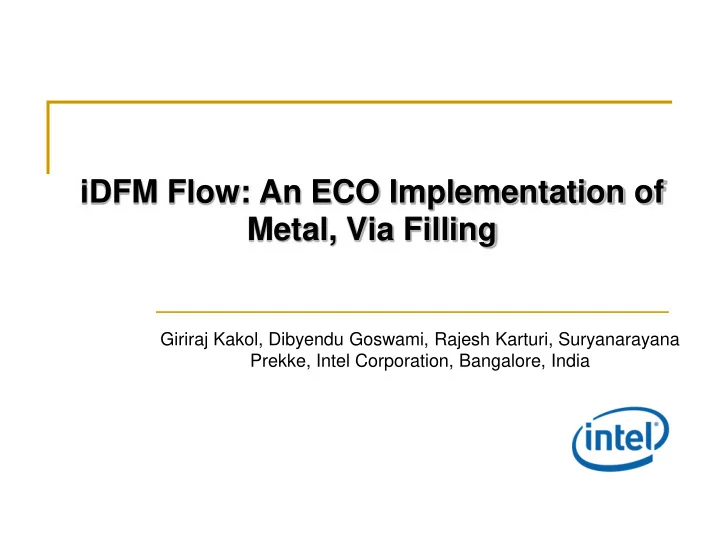

iDFM Flow: An ECO Implementation of Metal, Via Filling Giriraj Kakol, Dibyendu Goswami, Rajesh Karturi, Suryanarayana Prekke, Intel Corporation, Bangalore, India
Motivation As the complexity of designs and process design rules are growing with every generation, getting a correct by construction DFM fill is becoming increasingly difficult PDEs (Physical Design Engineers) end up spending huge manual effort in cleaning-up DRC and density violations All the manual effort is lost when there is a design ECO that makes previous fill polygons obsolete as it could potentially create DRCs, shorts on the ECO-implemented database. Running DFM flows from scratch is not viable as this would require spending the same amount of manual effort as before to clean up the DRCs Need automation to improve on ECO Layout productivity iDFM Flow: An ECO Implementation of Metal, Via Filling 2 ISPD 2013
Prior Art Manual Effort of cleaning the DRCs, Shorts Spends nearly two days on a typical ECO per partition Tedious and Error Prone iDFM Flow: An ECO Implementation of Metal, Via Filling 3 ISPD 2013
iDFM Filling Incremental Fill Flow relies on re-using the old fill data as much as possible No re-filling iDFM Flow: An ECO Implementation of Metal, Via Filling 4 ISPD 2013
Fill Legalization Detection and removal of shorts/DRCs DRCs are detected through foundry runset iDFM Flow: An ECO Implementation of Metal, Via Filling 5 ISPD 2013
Cleanup of Shorts Short is detected if a metX fill polygon overlaps or touches a metX design (route) polygon The ‘portion’ of the fill polygon that overlaps the design polygon is removed In case of metX fill touching the route polygon, it is shrunk along the preferred routing direction by 1 manufacturing grid so that ‘touch’ can be avoided. Any additional DRCs created at this stage are handled in later stages of DRC correction iDFM Flow: An ECO Implementation of Metal, Via Filling 6 ISPD 2013
iDFM Flow Steps Identify density failing windows (Metals/Vias) Trim Done on trimmed database incrementally re-fill without creating additional shorts. Density Fill flow doesn’t produce clean fill db as it Error? can’t comprehend all complicated DRCs at UDSM process nodes. Incremental Fill trimming cleans shorts, DRCs but refilling Filling introduces more DRCs which are addressed incrementally DRC analysis Certain cases need addition of small stubs to and Fixing fill/cell data depending on the design rule. TAT (Turn Around time) of iDFM is 6X faster Clean Fill DB than rerunning fill from scratch iDFM Flow: An ECO Implementation of Metal, Via Filling 7 ISPD 2013
iDFM Advantages Short clean fill: Removes the Original FILL polygons overlapping on ECO polygons for avoiding shorts. Shorter runtime: Incrementally FILLs Metals and Vias based on density and DRC requirements. DRC clean Filling: Set of algorithms to handle individual DRCs. Addresses Via density issues: Incrementally generates FILL Vias by connecting only the floating metal fills; without causing any shorts. Parallelize filling: Option to independently FILL set of Metal and Vias. Region Filling: BBOX option to correct only in the specified window. Easily portable: Easy portability to next process nodes. iDFM Flow: An ECO Implementation of Metal, Via Filling 8 ISPD 2013
Results Proved solution for ECO implementation on all in-house projects 99% of the DRCs introduced by the fill are being removed Shorts clean ECO DB with metal fill Very few density errors 6X improvement in TAT (Turn Around time) for ECO implementation. 8 person weeks of manual effort reduction on one of the internal CPU projects. iDFM Flow: An ECO Implementation of Metal, Via Filling 9 ISPD 2013
DRC Results Addressing DRC requirements through iDFM: 500 Pre iDFM DRCs 450 Post iDFM DRCs 400 350 300 250 200 150 100 50 0 Metal1 Metal2 Metal3 Metal4 Metal5 Metal6 Metal7 Metal8 iDFM Flow: An ECO Implementation of Metal, Via Filling 10 ISPD 2013
Density Results Addressing density requirements through iDFM: Pre iDFM Density failing windows Post iDFM density failing windows 80 70 60 50 40 30 20 10 0 Metal1 Metal2 Metal3 Metal4 Metal5 Metal6 Metal7 Metal8 iDFM Flow: An ECO Implementation of Metal, Via Filling 11 ISPD 2013
Conclusion Automated flow that replaces the tedious and error-prone manual approach of correcting the DRCs, shorts on ECO Database. Generic approach : Independent of process node. Judicious re-use of Foundry runsets (rules deck) Applied special treatment to the errors that are reported by the runsets to enable Metal/Via DRC and density errors. Bounding box and layer specific iDFM to improve throughput Incremental Refill on density failing windows iDFM Flow: An ECO Implementation of Metal, Via Filling 12 ISPD 2013
Back up slides for poster presentation iDFM Flow: An ECO Implementation of Metal, Via Filling 13 ISPD 2013
Incremental Refill: Original FILL and CELL: FINAL FILL and CELL after incrementally refilling to correct DRC/density : Fill Polygon Signal Polygon iDFM Flow: An ECO Implementation of Metal, Via Filling 14 ISPD 2013
Addressing complex DRVs Addition of stubs to Signal/FILL nets for cleaning DRCs. Patterning Signal/FILL nets for clean DRCs. iDFM Flow: An ECO Implementation of Metal, Via Filling 15 ISPD 2013
iDFM Flow: An ECO Implementation of Metal, Via Filling 16 ISPD 2013
Recommend
More recommend